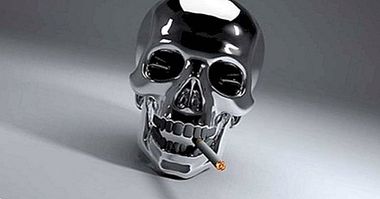How to stop drugs: basic information to get it
There are a lot of people in the world who have addiction to some kind of psychoactive substance. Continued consumption means that in the long run the body reacts by needing increasing amounts of substance at the same time it generates alterations in the biology and in the behavior of the subject that can end up having serious effects on his life, or even death.
In many cases people with drug dependence are not aware of the limitations and problems that their addiction poses, and in others they are not or are not able to combat the need to consume. How to stop drugs? In this article we will try to observe some of the procedures that are carried out in order to achieve cessation of consumption.
Drug addiction and how to stop drugs
We consider drug addiction or drug addiction to continued and excessive use of substances with psychoactive effects despite the existence of important negative consequences and the knowledge of suffering from these on the part of the affected.
The subject has been acquiring tolerance to the drug, requiring more and more of the substance to have an effect, and the cessation of consumption produces aversive symptoms (arising from the need for it to be acquired by the body to function normally). They can lead to continue consuming only by avoiding them.
The subject usually has little capacity to control of consumption, decreasing and limiting its performance and participation in different areas of life and dedicating much of the time and thought to consume or get this substance.
The transteoric model of Prochaska and DiClemente applied to the treatment of addiction
When working on the treatment of substance addiction, one of the main and best known models is the Transteoric model of Prochaska and Diclemente, which propose the existence of various phases through which a subject passes in the process of ending the addiction.
In these phases the subject would go through different mental and behavioral processes that would lead him little by little to cease consumption. But you have to keep in mind that it is not a linear process , but it is possible that there are several relapses and recoveries until achieving the final detoxification.
1. Precontemplation
The first of the phases contemplated in this model is that of precontemplation: the subject does not see his behavior as a problem and has no real desire to change, with which will not introduce changes unless they are forced to . The subject consumes and does not feel worried about it.
2. Contemplation
With the passage of time, there is an awareness in the individual that the consumption involves a loss of control, discomfort or a vital limitation and begins to consider that he has a problem.
This second phase, that of contemplation, is characterized by the birth of the will of Do something to end your addiction Coming soon, even though they have not made any attempt to do so yet.
3. Preparation for action
The third phase corresponds to the preparation for the action, in which the subject commits to change his behavior during the following month, having tried stop using for at least one day . The subject is highly motivated to achieve it.
- Maybe you're interested: "Types of motivation: the 8 motivational sources"
4. Action
In the action phase the commitment has been carried out in practice, using different techniques to avoid consuming and achieving a certain level of success.
5. Maintenance
Finally, if the abstinence is prolonged for at least six months the subject would enter a maintenance phase. In it, the subject focuses not on stopping consumption but on not relapsing into consumption. Is in this phase in which the highest probability of relapse exists .
This model also takes into account that relapse may occur in the patient, which would lead him or her to return to previous phases. It is possible that the relapse supposes feelings of helplessness arise, decreased self-esteem and surrender to addiction .
Performance in each of the stadiums
Given the different phases or stages proposed by the previous model, we can establish that throughout the process to stop drugs it will be necessary to use certain strategies or others.
1. Precontemplation stadium
In this phase it is important to make the subject see the existence of alterations and harmful effects of the substance . The approach to the problem is carried out from an educational perspective that aims to increase the level of awareness of the affected. This is the point at which someone begins to wonder about how to stop drugs.
However, it is necessary to use techniques that are not merely to provide information to the affected but to make this information meaningful. Visualize the experiences of addicted subjects or techniques such as role-playing or psychodrama can be useful .
2. When the subject is aware that he has a problem: contemplation phase
Once the individual begins to be aware that they have a problem, the next step is to reinforce that they look for information and know more and more the effects that consumption has had, has or can have in their lives.
We try to make a balance of The pros and cons of seeking treatment at the same time it is necessary that the subject expresses his thoughts, beliefs and emotions. The aim is that the subject does not assume a passive attitude towards addiction but feels responsible for choosing to change or not to do so.
You can also enter to assess the significance that consumption has for the subject, or to what he attributes it. Knowing these facts is fundamental for the person, since in many cases the addiction is used as escape from reality or stress caused by a situation or event.
Reflect on these facts and conduct behavioral experiments that allow you to test your beliefs (this must be done with the help of a professional) can help generate a change .
- Maybe you're interested: "Types of psychological therapies"
3. Preparation for action
In this phase the subject has decided to change, being necessary to establish stable objectives and taking into account that an addiction can not be left generally from one day to the other.
It is necessary to be clear that it supposes a process that can be prolonged in time, and that in fact the sudden withdrawal of a substance to which one is dependent can generate dangerous abstinence syndromes. In this way, the objectives and deadlines to be established must be realistic. It is at this stage that the action plan to stop drugs is drawn up.
4. Action
It is in these phases that the core of treatments for drug addiction is usually concentrated. The treatment to be applied will depend to a great extent on the type of substance to which one is addicted and the characteristics of the subject and his / her environment. Methodology of cognitive-behavioral type is usually used , often also using different psychotropic drugs in the process of disengagement.
If it has not been done before, it is advisable to investigate the meaning that the subject attributes to the substance and its consumption and the beliefs that it has regarding it, identifying if it supposes some type of advantage and the problems caused by the addiction. In some cases it may be necessary the use of cognitive restructuring to modify them.
One of the therapies that has proved most effective (at least in alcohol and cocaine) is the approach to community reinforcement, in which elements focused on the social environment are specially worked on.
Training is applied in communication skills that allow an improvement in the affective bond with the environment and the expression of sensations and thoughts, activities not related or incompatible with the consumption of the substances are prescribed. a training is done to face the craving . It is usually accompanied by the use of unpleasant substances that are associated with consumption, such as disulfiram in alcoholics and cocaine addicts.
The management of contingencies is also used as an important part of therapy, controlling the elements that make consumption somewhat appetizing and reinforcing. For example, the social approval of consumption in certain environments . It is intended to analyze and modify these elements while positively reinforcing non-consumption. Agonist substances such as methadone in the case of heroin, or antagonists such as naltrexone can also be used.
- Related article: "Craving: causes and symptoms of the desire for substance use"
5. Maintenance
Once the cessation of consumption has been achieved, it is very important to establish a follow-up and elaborate guidelines and mechanisms that allow relapse prevention. In this sense, it is necessary to reinforce the coping skills and the sense of control and self-efficacy of the patient, as well as to control exposure to environments where the substance is easy to achieve as far as possible.
In some drugs, group therapy has also been used or assistance to support groups (especially in the case of alcoholism) to share feelings with someone similar after arrival at the maintenance period.
It may be the case that the subject comes to make an isolated consumption, violating abstinence. Even in the case that the subject comes to consume again, we must be clear that a fall does not imply a relapse as long as the habit is not reintroduced.
It would be necessary to analyze the circumstances that have led to the new consumption and establish plans to prevent its recurrence , and avoid that the subject is considered incapable of achieving abstinence due to said consumption.
Elements to keep in mind when leaving drugs
Regardless of the aforementioned actions, in order to stop drugs, it is essential to take into account and work on different aspects.
1. Perception of the harmful consequences of consumption
One of the fundamental elements and the first that must be taken into account when dealing with an addiction is the fact that the subject must be able to see that he has a problem.
The information and the capture of the functional and personal limitations, the sensation of loss of control before the substance or the need to possess it, the physical and somatic problems produced by it, the diminution of faculties or the reduction of capacity to sustain a work activity or when establishing and maintaining social relationships are some of the aspects in which the subject can be fixed to realize the problem.
It is a key part of the treatment, without which it is difficult for the subject to remain in abstinence of his own free will.
2. Perception of self-efficacy
Another important element when it comes to having or not to stop drugs is the perception that the subject has of himself and his ability to control his behavior.
It is necessary that the subject perceives himself as competent and capable so that he is responsible for acting to stop the consumption. However, an excess is not good either, given that favors the "I control" which causes many people to continue consuming.
3. Sense attributed to the fact of consuming
What it means to consume for the subject and why it does it is a very important point to explain and work the addictive process. The beliefs and thoughts about it can be modified and shaped in order to achieve that are adaptive to the needs of the subject .
4. Existence of advantages for consumption
Some dependents consider that the maintenance of consumer behavior brings benefits, not wanting to stop using or presenting resistance to finish doing so because abstinence would mean the end of these.
For example, for some, dependence is a way of escaping from reality, of traumatic experiences or situations that are not able to control. In other cases, being dependent supposes a behavioral disinhibition and / or an increase in family or amical care, a way to make the subject seen and there is concern about their condition. There are also people who associate consumption with another type of receive economic benefits
5. The role of expectations
It is very important to bear in mind that to stop consuming something to which we are dependent is not usually a simple or short process, requiring time to achieve complete abstinence and being possible that there are relapses in the process.
It's not about not believing that we're going to get rid of drugs , but in keeping in mind that it will not be easy and will require great effort and suffering on our part.
6. Analysis of the context
The social context in which we each move is of great importance when it comes to explaining our thoughts about drugs and their use.
For example, in some environments consumption is seen as something desirable and well seen, favoring the acquisition of dependence. It is one of the reasons that, for example, leads many young people to start smoking . It may be necessary to intervene or make changes in the context during the treatment.
- You may be interested: "The two faces of tobacco dependence (chemical and psychological)"
7. Social relations and social support
The process of stopping the consumption of a substance to which one is dependent is very hard and complicated, the participation of the social environment having great importance in its success. Family and friends are a great source of help and support that allow the subject to be controlled at the same time that they serve as stimuli that motivate the subject to achieve abstinence.
Bibliographic references:
- Belloch, Sandín and Ramos (2008). Manual of Psychopathology. McGraw-Hill. Madrid.
- Santos, J.L. ; García, L.I. ; Calderón, M.A. ; Sanz, L.J .; de los Ríos, P .; Left, S .; Román, P .; Hernangómez, L .; Navas, E .; Thief, A and Álvarez-Cienfuegos, L. (2012). Clinical psychology. CEDE Preparation Manual PIR, 02. CEDE. Madrid.



















